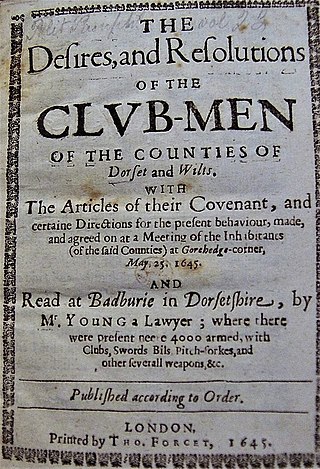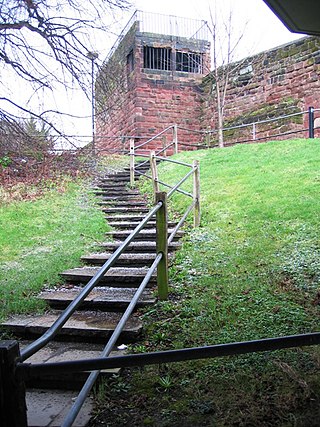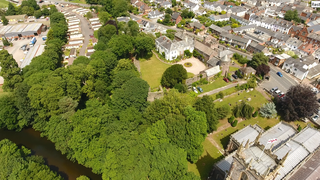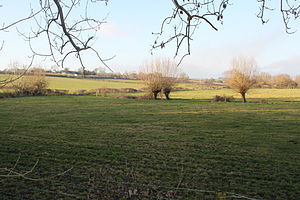
The Battle of Marston Moor was fought on 2 July 1644, during the Wars of the Three Kingdoms of 1639–1653. The combined forces of the English Parliamentarians under Lord Fairfax and the Earl of Manchester and the Scottish Covenanters under the Earl of Leven defeated the Royalists commanded by Prince Rupert of the Rhine and the Marquess of Newcastle.

The Battle of Naseby took place on 14 June 1645 during the First English Civil War, near the village of Naseby in Northamptonshire. The Parliamentarian New Model Army, commanded by Sir Thomas Fairfax and Oliver Cromwell, destroyed the main Royalist army under Charles I and Prince Rupert. Defeat ended any real hope of Royalist victory, although Charles did not finally surrender until May 1646.

The New Model Army was a standing army formed in 1645 by the Parliamentarians during the First English Civil War, then disbanded after the Stuart Restoration in 1660. It differed from other armies employed in the 1639 to 1653 Wars of the Three Kingdoms in that members were liable for service anywhere in the country, rather than being limited to a single area or garrison. To establish a professional officer corps, the army's leaders were prohibited from having seats in either the House of Lords or House of Commons. This was to encourage their separation from the political or religious factions among the Parliamentarians.

George Goring, Lord Goring was an English Royalist soldier. He was known by the courtesy title Lord Goring as the eldest son of the first Earl of Norwich.

The sieges of Taunton were a series of three blockades during the First English Civil War. The town of Taunton, in Somerset, was considered to be of strategic importance because it controlled the main road from Bristol to Devon and Cornwall. Robert Blake commanded the town's Parliamentarian defences during all three sieges, from September 1644 to July 1645.

The Ironsides were troopers in the Parliamentarian cavalry formed by English political leader Oliver Cromwell in the 17th century, during the English Civil War. The name came from "Old Ironsides", one of Cromwell's nicknames.

Clubmen were bands of local defence vigilantes during the English Civil War (1642–1651) who tried to protect their localities against the excesses of the armies of both sides in the war. They sought to join together to prevent their wives and daughters being raped by soldiers of both sides, themselves being forcibly conscripted to fight by one side or the other, their crops and property being damaged or seized by the armies and their lives threatened or intimidated by soldiers, battle followers, looters, deserters or refugees. As their name suggests, they were mostly armed with cudgels, flails, scythes and sickles fastened to long poles. They were otherwise unarmed.
The Eastern Association of counties was an administrative organisation set up by Parliament in the early years of the First English Civil War. Its main function was to finance and support an army which became a mainstay of the Parliamentarian military effort until early 1645, when many of its units were incorporated into the New Model Army.
Events from the year 1645 in England. This is the fourth year of the First English Civil War, fought between Roundheads (Parliamentarians) and Cavaliers.

Cornwall played a significant role in the English Civil War, being a Royalist enclave in the generally Parliamentarian south-west.
1645 was the fourth year of the First English Civil War. By the beginning of 1645 the war was going badly for Charles I and the campaigns of 1645 did not see a recovery in his prospects.

Sir John Stawell or Stowell, 29 August 1600 – 21 February 1662, was MP for Somerset at various times from 1625 to 1662, and one of the leading Royalists in the West Country during the First English Civil War.

Sir Edmund Wyndham was an Somerset landowner, and Member of Parliament on different occasions between 1625 and 1679. He supported the Parliamentary opposition to Charles I, until 1630, when his wife was appointed wet-nurse to the Prince of Wales.

During the English Civil War (1642–1651), Bristol was a key port on the west coast of England and considered strategically important by both Royalists and Parliamentarians. Initially, the leadership of Bristol wanted to keep the city neutral in the conflict. In 1642, city officials implored Thomas Essex not to occupy the city with his Parliamentarian forces. The city was weakly defended, and Essex entered without much resistance. During the conflict, Bristol was used as a receiving point for the Royalists to accept reinforcements from Ireland. The town was well fortified by the Frome and Avon rivers, as well as a medieval castle, which had been bought by the corporation when the First English Civil War broke out in 1642, and during the Parliamentary defense, earthen artillery forts.

The Second Siege of Bristol of the First English Civil War lasted from 23 August 1645 until 10 September 1645, when the Royalist commander Prince Rupert surrendered the city that he had captured from the Parliamentarians on 26 July 1643. The commander of the Parliamentarian New Model Army forces besieging Bristol was Lord Fairfax.
The battle of Bovey Heath took place on 9 January 1646 at Bovey Tracey and Bovey Heath during the First English Civil War. A Parliamentarian cavalry detachment under the command of Oliver Cromwell surprised and routed the Lord Wentworth's Royalist camp.

The Siege of Tiverton took place in October 1645 during the First English Civil War, when a Royalist garrison surrendered to a detachment of the New Model Army.

The Siege of Bridgwater took place in July 1645, during the First English Civil War, when a Royalist garrison surrendered to a Parliamentarian force under Sir Thomas Fairfax.
The Battle of Sherburn in Elmet was an action fought towards the end of the First English Civil War. A detachment of the English Royalist army led by Lord Digby, King Charles I's Secretary of State, was making a belated attempt to reach Scotland and join forces with the Scottish Royalists. As they moved north through Yorkshire, they were pursued by a Parliamentarian force under Sydnam Poyntz. Poyntz was unaware of the Royalists' position, and the Royalists took the opportunity to ambush and attack a small Parliamentarian detachment at night in the village of Sherburn in Elmet. However, the Royalists then mistook fleeing Parliamentarians for their own men and panicked. In the ensuing flight, several hundred Royalist prisoners were taken. The Parliamentarians also captured Digby's coach, which contained much compromising correspondence.















